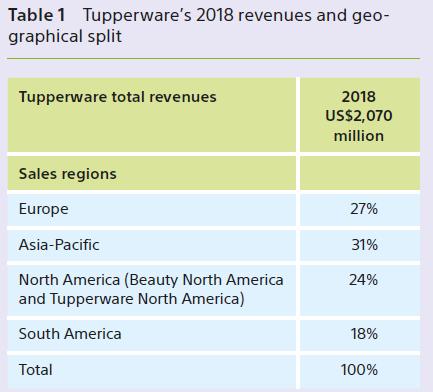Company founder Earl Tupper was an early plastics pioneer. The young inventor found work at DuPont in
Question:
Company founder Earl Tupper was an early plastics pioneer. The young inventor found work at DuPont in the 1930s without the benefit of a college education.
By 1938, Tupper was ready to strike out on his own and devote himself to research in plastics. That year he started his own company, leaving DuPont with only his experience and a discarded piece of polyethylene. In 1946, he founded a new company, Tupperware, and began manufacturing food storage and serving containers with Poly-T.
Tupperware Corporation (www.tupperware.com), whose well-known Tupperware parties have spread to more than 100 countries, is one of the largest direct sellers in the world. Relying on independent consultants rather than employees for sales, the company generated more than US$1 billion in revenues, already in 1998. Although Tupperware’s mainstay for 50 years had been plastic food storage containers, in the 1990s the company expanded into kitchen tools, small appliances and baby and toddler products. Although US sales declined steadily in the 1980s and 1990s, international sales expanded, with the result that more than 85 per cent of company revenues came from international business in the mid-1990s. The economic declines in the Far East and Latin America in the late 1990s left Tupperware with overall falling sales and an unsure outlook for the coming years.
Tupperware’s direct selling model
The most successful early direct seller of Tupperware was Brownie Wise, a Detroit secretary and single mother. Tupper hired her in 1951 to create a direct selling system for his company. Within a few months, Tupper had established the subsidiary Tupperware Home Parties, Inc. and had abandoned selling his products through retail stores. Wise’s home party system used a sales force of independent consultants who earned a flat percentage of the goods they sold and won incentives in the form of bonuses and products.
By the late 1950s, Tupperware had become a household name. With almost no advertising, Tupperware had created phenomenal brand awareness.
The company’s rapid success can be attributed to its recruitment of almost 9,000 independent consultants by 1954, most of them women, and their enthusiastic spread of Tupperware parties, because Tupperware home parties provided an easy entry into the workforce for women. Tupperware understood what women at that time were going through.
The company wanted to give them a sense of self-esteem and so came up with the idea of ‘Tupperware parties’. Here women came together in their homes to talk about kitchen goods and other issues. In this way the women had the opportunity to own a business and make some money. This was the forerunner to what many marketing systems now call ‘direct marketing’.
During the 1960s and 1970s, Tupperware created a range of toys targeted at various stages of a child’s development.
In the 1980s, Tupperware launched products designed to minimize cooking time and products specially designed for microwave and conventional ovens.
Despite encountering some financial problems at the beginning of the 1990s, overall sales continued to improve in the mid-1990s, in part fuelled by massive product introductions. Tupperware brought out approximately 100 new products between 1994 and 1996, including entire new product lines and speciality items catering to particular needs internationally, such as Kimono Keepers in Japan. As had been the case during the last decade, international sales growth outstripped that in the US. Sales in the Far East and Latin America boomed, while sales in the US improved slowly. As a result, by 1996, Tupperware relied on international business for 85 per cent of its revenues and 95 per cent of its profits.
In 2005, Tupperware acquired all the assets in International Beauty from Sara Lee. Following the acquisition, the company changed its corporate name from the Tupperware Corporation to the Tupperware Brands Corporation.
Tupperware in 2018
The company’s product brands and categories include preparation, storage and serving solutions for the kitchen and home through the Tupperware brand, and beauty and personal care products. Its products are sold under eight brand names: Tupperware, Armand Dupree, Avroy Shlain, BeautiControl, Fuller, NaturCare, Nutrimetics and Nuvo.
The company recorded revenues of US$2,070 million during the financial year ended December 2018 (FY2018), a decrease of 30 per cent compared to five years earlier (FY2013). The operating profit (net income) of the company was US$216 million in FY2018, a decrease of more than 50 per cent compared to FY2013.
By the end of 2018, the number of employees was 13,000 (not including the worldwide sales force) (see also Table 1).

Questions
1. How would you characterize Tupperware’s distribution strategy in relation to the theoretical models?
2. What are the advantages and disadvantages of Tupperware’s distribution model?
3. How would you evaluate the future for this distribution model?
4. In the last five years, Tupperware has witnessed sales decline across most of its markets. Which criteria would you use in order to find out which of the three countries should have Tupperware’s focus in the next three years?
Step by Step Answer:






